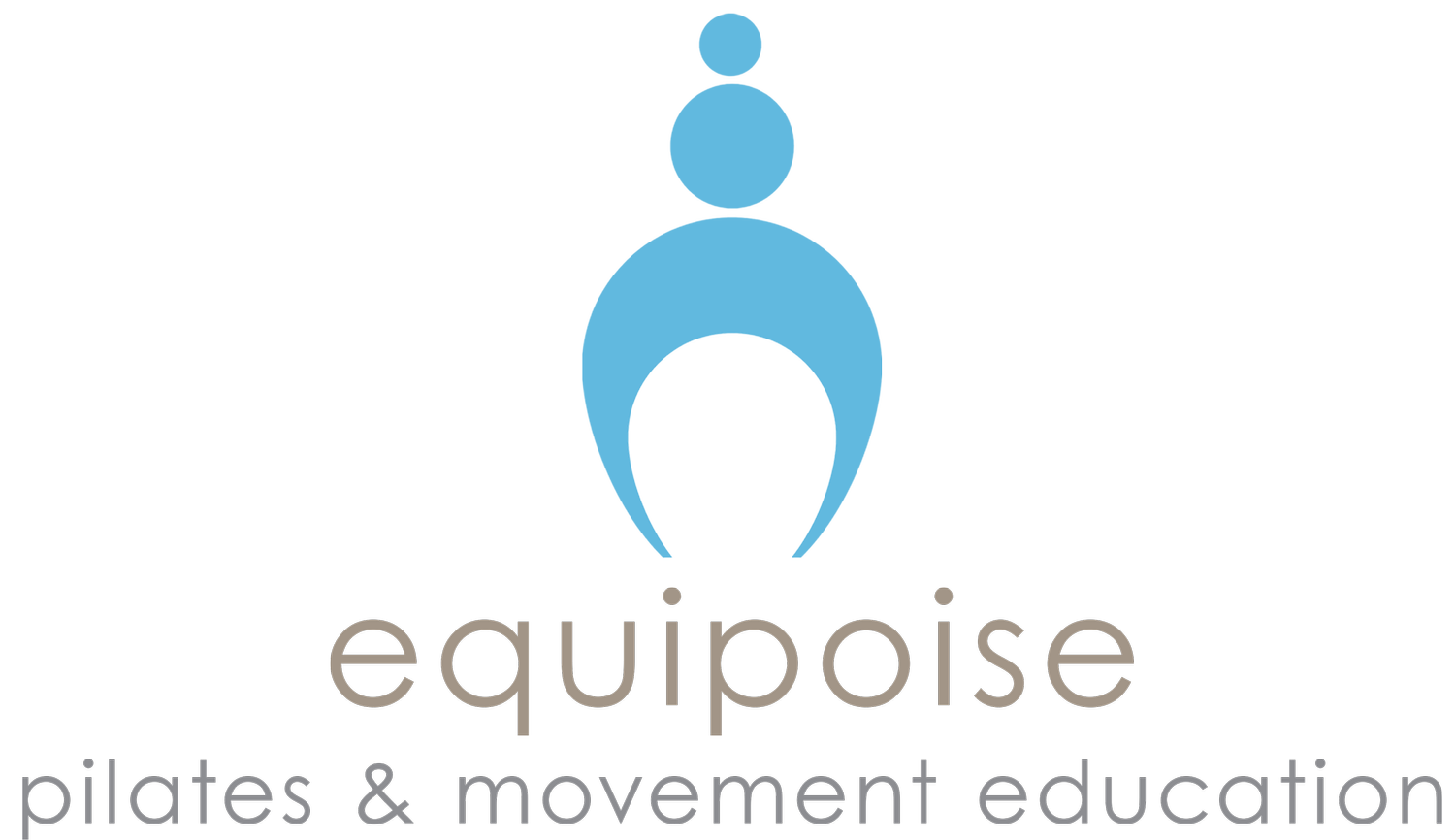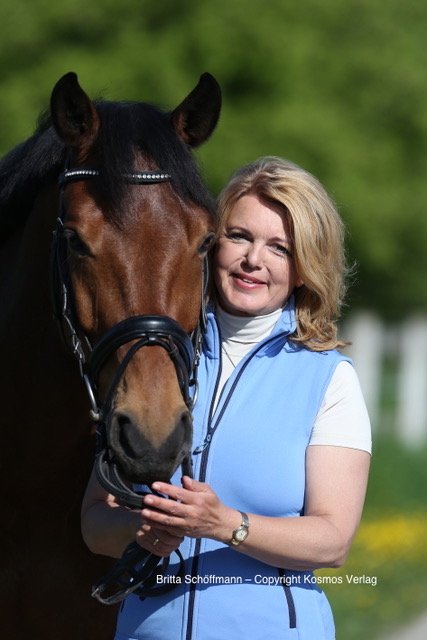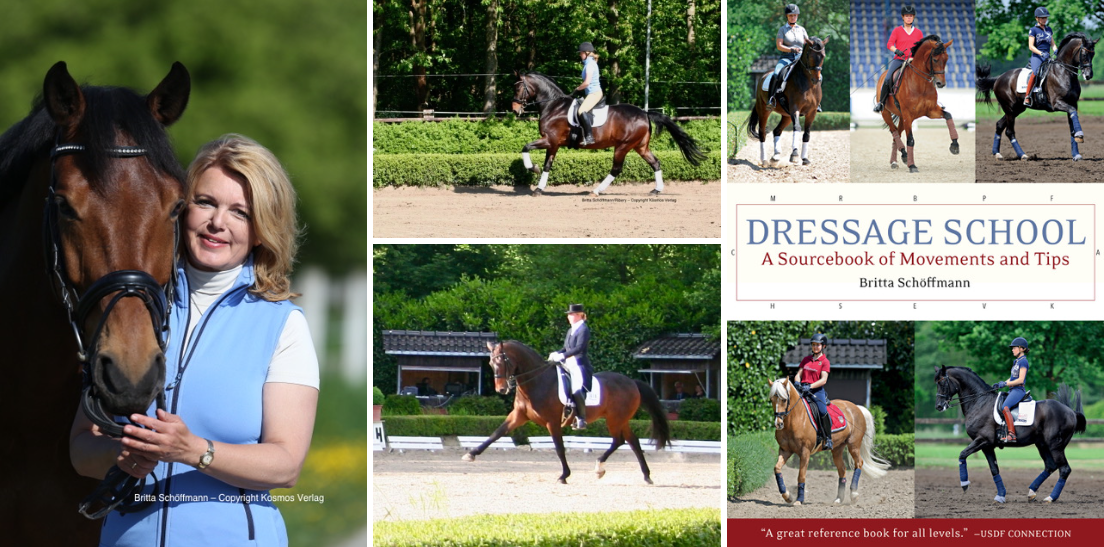Interview with Dr Britta Schöffmann
On my Equipoise Pilates for Equestrians website I have a quote from Mr Charles de Kunffy from his book ‘The Ethics and Passions of Dressage’, the quote reads ‘The horse cannot go better than the rider will allow’. This quote has always inspired me in my work as an equestrian Pilates practitioner, and also made me curious. From this curiosity, I wanted to start a dialogue as to how we can best support our horses physical and emotional well being. My central idea here is how we, through being our best selves, give our horses the greatest chance to be the best that they can be. We can do this by maintaining our bodies and minds for optimal performance, regardless of our age or our level of competency.
Dr Britta Schöffmann is Former Grand Prix Dressage rider, a trainer and competition judge. She has a PhD in Sports Science from the German Sport University in Cologne and did her Diploma thesis on ‘The Social Structure in Riding Clubs’ (Zur Sozialstruktur von Reitvereinen’) and her PhD thesis on ‘Equitation in a Subjective and Social Context (Reitsport im Subjektiven und Sozialen Kontext). Dr Schöffmann is also a journalist and prolific author of numerous books on Dressage including in English, ‘Klaus Balkenhol – The man and his methods’, ‘Dressage School’, “Dressage Training Customised’. In German (currently, but hopefully to be translated to english) ‘So Lernen Pferde Reiterhilfen’ (How Horses Learn the Riders Aids), ‘Die Dressurstunde’ (Dressage Training Lessons), ‘Die Skala der Ausbildung’ (The Training Scale), ‘Aufgabenreiten Leicht Gemacht” (Riding A Test), ‘So Gelingt die Dressurprüfung’ (To Succeed in the Dressage Test).
Dr Schöffmann works freelance for various journals, one of which is the German Equestrian Federation (FN). She was the lead author and editor in the FN book ‘Understanding Horses – Handling and Groundwork’ and worked as a dressage expert advisor on the revision of the FN Guidelines Bd.1 ‘Basic Training for Rider and Horse’. She created and features in episodes 3, 4, 5, 6, & 7 in the ‘Dressage Explained‘ series of instructional DVD’s for WeHorse, formerly Pferdia. She is also a contributing instructor to WeHorse, a German subscription based online learning platform.
Dr Schöffmann is the holder of the Gold German Riding Badge, a Federation Nationale riding qualification, a performance medal. The Bronze and Silver medals can be obtained through qualification tests consisting of dressage, jumping, and theory, ascending in the degree of difficulty at each level. The Gold Badge is obtained only after the rider has won at least 10 S-Level (Prix St. George and upward) Dressage tests.
She has trained throughout her riding career with Fritz Tempelmann, Willi Schultheis, Harry Boldt, Jean Bemelmans and Klaus Balkenhol.
I am keen to talk to Dr Schöffmann about how she feels the riders body plays a role in the movement, performance, and longevity of the horse in Dressage. I am particularly interested to discover if she draws upon a scientific understanding of human biomechanics, which takes account of equine biomechanics, in this regard.
I am a huge fan of Dr Schöffmann’s work and find her book ‘Dressage School – A Sourcebook of Movements and Tips’ a fantastic reference that I refer to constantly. I feel honoured to have interviewed her for my Blog and I hope that you enjoy learning more about her and her work.
Firstly Britta, thank you so much for taking the time to talk to me, I feel very honoured.
1.You have worked with some incredible trainers in Fritz Tempelmann, Willi Schultheis, Harry Boldt, Jean Bemelmans and Klaus Balkenhol, has there been one trainer that has influenced you the most? If so, in what ways?
Helen, it is pleasure and an honour for me to be in you Blog. Talking about these wonderful trainers – I even rode a clinic with Mr de Kunffy in the eighties in Oregon USA – I can say that every single one influenced me and I learned from them all. But I can say that Fritz Tempelmann was probably the one that inspired me the most, maybe because I was around 16 years old when I trained at his stable. I heard and still hear his voice and his advice through my whole riding career sitting on horseback. One of his theories was “they have to be easy going”. He meant the horses and the way they could be ridden. I also followed his way in how to build up the training (of the horse) – the single lesson and the big picture.
2.You have a PhD on Sports Science, do you believe this has influenced you as a dressage rider and trainer? If so, how?
Maybe as a trainer, less so as a rider because I was a rider long before I got my PhD. But as a trainer I remember many things out of my University time, things like training structure, methodology and didactics, exercise physiology and psychology. This knowledge helped and still helps.
3.In your training videos you give very clear concise instructions to your riders. Do you believe this clarity is product of your classical training? I am also particularly interested in whether your knowledge of anatomy and biomechanics contributes to this?
Well, I like to explain things clearly and vividly because I think it is most important that a rider not only does what I tell him but understands why and what for he does it. I want that the rider internalises his actions and become able to solve upcoming problems in the saddle whether I am with him or not. My knowledge about anatomy and also about physiology and biomechanics helps me, that’s for sure.
4.In your DVD ‘Dressage Explained Part 3. Suppleness Through Flexion and Bend’ you say “the rider should sit quietly”. What qualities do you believe a rider needs to be able to achieve a quiet seat?
I believe a rider should have basic physical fitness and agility himself, otherwise he would never be able to find and maintain balance on the horse. And a balanced seat is the basis for the ability to a preferable quiet seat that doesn’t disturb the horses movement.
5.In the same DVD you say to a young rider on a 4yo horse to “try to ride with perfect classical aids” and to only diversify briefly if there is a need. Can you tell me what you believe is the role and value of perfect classical aids and why they are important?
Quite often I watch the riders, when things don’t run so well, try tricks to whitewash the problem instead of giving and following the right and appropriate aid. But only in repeating the correct aid in the correct moment and in a correct intensity the horse gets the chance to understand what it is supposed to do. When a rider uses just tricks it will be difficult for the horse to generalise and to learn.
6.Do you believe the position of the rider is important regarding the application of ‘perfect classical aids’? If so, why?
Absolutely! The position of the rider, the balanced seat, is the basis for influence on the horse. One example: many riders tend to lean back during a halt or half halt. They want to stop the horse but since their body gets behind the vertical their weight exerts pressure on the horses back and so pushes the horse forward instead of helping him to reduce tempo or even halt. Since I love to speak in pictures I explain this to my students like this: Imagine you would sit on a huge ball. What would happen when you lean back, where would the ball roll? Every student knows that the ball would roll forward and in the moment they realise this, they all of a sudden quit leaning back. The balanced seat also allows the rider to sit quietly without unplanned movements neither of the body nor the hands. That guarantees that planned action can be noticed by the horse.
7.How big a role do you feel the riders body and position play in the athleticism, performance and longevity of the dressage horse?
The better the riders position on the horse is the less the riders weight disturbs. Is a rider capable of following all the horses movements balanced, flexible and springy, the two bodies can (nearly) become one. Horse and rider should merge like a dancing centaur.
8.As you are aware, I am a Pilates Movement Educator who works with equestrians. Do you have routine to improve, maintain or support your body for riding? If so, what do you do?
I must admit, that during my active riding career, I was bit lazy about doing my own gym, except during my time at the Sports University. After that I used to ride five, six horses a day next to my job so I just didn’t have the time to train anything else. But since now I don’t ride so much any more but still want to stay fit for my students horses I started EMS training (electronic muscle stimulation) a training with electricity. The advantage: it only takes 20 minutes once a week. If it helps? I don’t know yet. Maybe I should start with Pilates, but I guess that needs a bit more effort….
9.As a final question I would like to know your thoughts on Mr de Kunffy’s quote ‘The horse cannot go better than the rider will allow’. Do you agree with this? And if so, why?
Well, I absolutely agree with Mr de Kunffy. Since a horse has no idea what a good dressage performance looks like – horses do not usually read books – the rider has to lead it to be, or to become, good at what it does in the arena. Only when the rider is capable to communicate with the horse properly it can evolve its talents. As Paul Stecken once said: “Horses like to go right!”
Thank you very much for your time Britta!
(Mr Paul Stecken was the mentor of Ingrid Klimke and for 35 years was the head of the Westphalian Riding and Driving School in Münster, Germany, where he taught a young Reiner Klimke. He was a proponent of the classical principles of riding. He passed away at the age of 100 in September 2016.)
The revised edition of Dr Britta Schöffmann’s ‘Dressage School – A sourcebook of Movements and Tips’ will be available, in English, along with the DVD’s from the ‘Dressage Explained’ series in January 2019 from http://www.horsebooks.com.au


